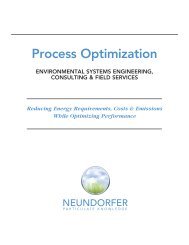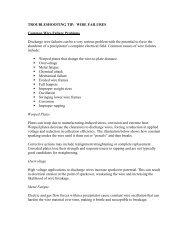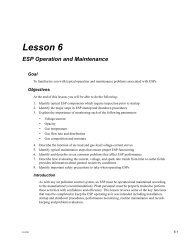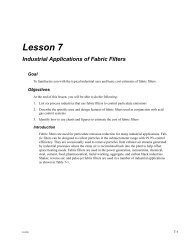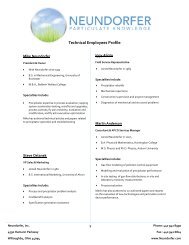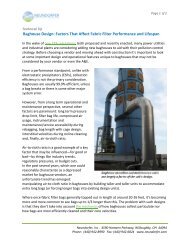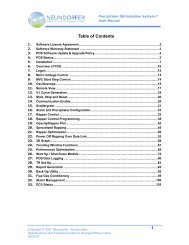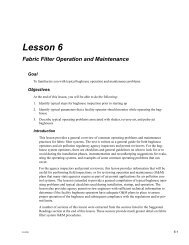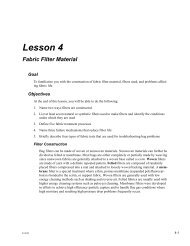Lesson 5 Fabric Filter Design Review
Lesson 5 Fabric Filter Design Review
Lesson 5 Fabric Filter Design Review
Create successful ePaper yourself
Turn your PDF publications into a flip-book with our unique Google optimized e-Paper software.
<strong>Fabric</strong> <strong>Filter</strong> <strong>Design</strong> <strong>Review</strong><br />
Typical Air-To-Cloth Ratios<br />
During a permit review for baghouse installations, the reviewer should check the A/C ratio.<br />
Typical A/C ratios for shakers, reverse-air, and pulse-jet baghouses are listed in Table 3-1,<br />
<strong>Lesson</strong> 3.<br />
Baghouses should be operated within a reasonable design A/C ratio range. For example,<br />
assume a permit application was submitted indicating the use of a reverse-air cleaning baghouse<br />
using woven fiberglass bags for reducing particulate emissions from a small foundry<br />
furnace. If the information supplied indicated that the baghouse would operate with an A/C<br />
ratio of 6 (cm 3 /sec)/cm 2 [12 (ft 3 /min)/ft 2 ] of fabric material, you should question this information.<br />
Reverse-air units should be operated with a much lower A/C ratio, typically 1 (cm 3 /sec)/<br />
cm 2 [2 (ft 3 /min)/ft 2 ] or lower. The fabric would probably not be able to withstand the stress<br />
from such high filtering rates and could cause premature bag deterioration. Too high an A/C<br />
ratio results in excessive pressure drops, reduced collection efficiency, blinding, and rapid<br />
wear. In this case a better design might include reducing the A/C ratio within the acceptable<br />
range by adding more bags. Another alternative would be to use a pulse-jet baghouse with the<br />
original design A/C ratio of 6 (cm 3 /sec)/cm 2 [12 (ft 3 /min)/ft 2 ] and use felted bags made of<br />
Nomex fibers. However, Nomex is not very resistant to acid attack and should not be used<br />
where a high concentration of SO 2 or acids are in the exhaust gas. Either alternative would be<br />
more acceptable to the original permit submission.<br />
Typical air-to-cloth ratios for baghouses used in industrial processes are listed in Tables 5-1<br />
and 5-2. Use these values as a guide only. Actual design values may need to be reduced if the<br />
dust loading is high or the particle size is small. When compartmental baghouses are used, the<br />
design A/C ratio must be based upon having enough filter cloth available for filtering while<br />
one or two compartments are off-stream for cleaning.<br />
Table 5-1. Typical A/C ratios [(ft 3 /min)/ft 2 ] for selected industries 1<br />
Industry<br />
<strong>Fabric</strong> filter air-to-cloth ratio<br />
Reverse air Pulse jet Mechanical<br />
shaker<br />
Basic oxygen furnaces 1.5-2 6-8 2.5-3<br />
Brick manufacturing 1.5-2 9-10 2.5-3.2<br />
Castable refractories 1.5-2 8-10 2.5-3<br />
Clay refractories 1.5-2 8-10 2.5-3.2<br />
Coal-fired boilers 1-1.5 3-5 -<br />
Conical incinerators - - -<br />
Cotton ginning - - -<br />
Detergent manufacturing 1.2-1.5 5-6 2-2.5<br />
Electric arc furnaces 1.5-2 6-8 2.5-3<br />
Feed mills - 10-15 3.5-5<br />
Ferroalloy plants 2 9 2<br />
Glass manufacturing 1.5 - -<br />
Grey iron foundries 1.5-2 7-8 2.5-3<br />
Iron and steel (sintering) 1.5-2 7-8 2.5-3<br />
Kraft recovery furnaces - - -<br />
Continued on next page<br />
2.0-3/95 5-5



